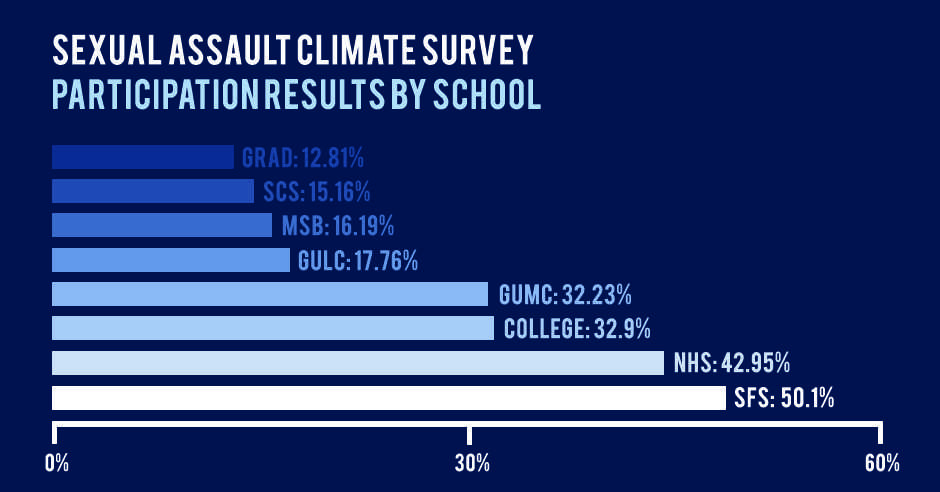
Twenty-seven percent of students have completed the Georgetown Sexual Assault and Misconduct Climate Survey as of Monday morning, currently falling short of the university’s 50 percent participation rate goal, according to an email from Vice President of Institutional Diversity and Equality Rosemary Kilkenny.
The university has extended the survey completion deadline from Feb. 6 to Feb. 15 in an effort to boost participation numbers.
The survey was originally released to the student body Jan. 14, and is based on a template developed by the Association of American Universities in late 2014. Twenty-seven other universities, including Harvard University, Yale University and the University of Pennsylvania use the survey.
The Sexual Assault Working Group and a misconduct climate survey working group tailored the survey specifically to be used at Georgetown.
University President John J. DeGioia stressed the importance in assuring that as many students as possible respond to the survey.
“I wish to thank all of our students who have contributed to this survey, and I would like to encourage all students who have not yet taken it to participate over the next two weeks,” DeGioia wrote in an email to The Hoya. “Every response gives us important insights into how we can shape our ongoing efforts to build an environment where everyone can thrive.”
The survey has an average 19 percent participation rate among participating schools. Harvard had a 53 percent participation rate when it took the survey, Yale had 52 percent, the University of Pennsylvania had 27 percent, Brown University had 36 percent and the University of Arizona had 8 percent.
The School of Foreign Service holds the highest participation rate among Georgetown schools, with participation from 50 percent of its students. Georgetown’s Graduate School of Arts and Sciences holds the lowest participation rate at around 13 percent as of Jan. 28.
Only 16.3 percent of McDonough School of Business undergraduate students have taken the survey, while 32.9 percent of students in the College and 43 percent of students in the School of Nursing and Health Studies have taken the survey.
Kilkenny, who previously served as the university’s Title IX coordinator and on the Sexual Assault Working Group, said it would be difficult to predict the final participation rate.
“We have never collected this kind of data so it is hard to say what the impact of participation will be when the survey closes on Feb. 15,” Kilkenny wrote in an email to The Hoya. “Reaching this aspirational goal [of 50 percent] as a campus, or among the representative sample, will be tremendously helpful to our work.”
Georgetown University Student Association Secretary Maddy Moore (SFS ’17), who is also a member of the Sexual Assault Working Group, said that even though the school is falling short of the 50 percent participation rate, the survey has still done well.
“We were obviously shooting for something higher than the national average, so I’m glad that we’ve surpassed it, but it would be great if we got more people to participate and it would be great if we could break 50 percent,” Moore said.
Kilkenny said she is hopeful that the final participation rate will climb.
“Given that we have extended the survey by a week and that it takes most students less than 20 minutes to complete the survey, I am hopeful our undergraduate, graduate and professional students and their allies will rally to make sure as many people as possible participate in the next two weeks to give us the most data,” Kilkenny wrote.
The university has employed various marketing strategies to encourage student participation, including hanging posters around campus and encouraging clubs to email their members. GUSA has also started advertising in the past week.
Moore said student marketing has helped the participation rate.
“I think that student drives towards the marketing effort has made a difference,” Moore said. “I think sometimes people have seen all these posters and gotten emails that can be very passive, whereas hearing from students they start to realize why this survey is something that they should participate in.”
Health Education Services is also offering walk-in sessions for students who want support in the vicinity while taking the survey.
Moore said she hopes all students will realize the importance of participating.
“What I’ve been telling people is really urging them that sexual violence is a community issue, it’s something that impacts the entire community, you might not know it, but it can impact your roommate, it can impact a loved one, someone on your floor, and it’s something that we should all work toward ending and raising awareness around,” Moore said.
According to GUSA President Joe Luther (COL ’16), it is important for as many students as possible to participate in order to ensure the survey’s accuracy.
“That survey is critical for years to come in terms of informing how we talk about sexual assault policy and how the campus climate is. So, the more responses we get, the more accurate this can be,” Luther said.
Francesca Sacchi (COL ’18) said she has not taken the survey because of its length.
“It takes half an hour and I could be doing homework and other stuff at that time,” Sacchi said. “They advertised it for 15 minutes, but then it took people 25. My friends have done it.”
According to Kilkenny, the survey has taken an average of 20 minutes.
Marjorie Fuchs (COL ’16) said she took the survey to help make a difference.
“I took the survey because I thought sexual assault is an extremely important issue on campus and I thought that it was really important to have my own voice and the voices of my peers heard to make a difference in something that is often seen as taboo,” Fuchs said.




















